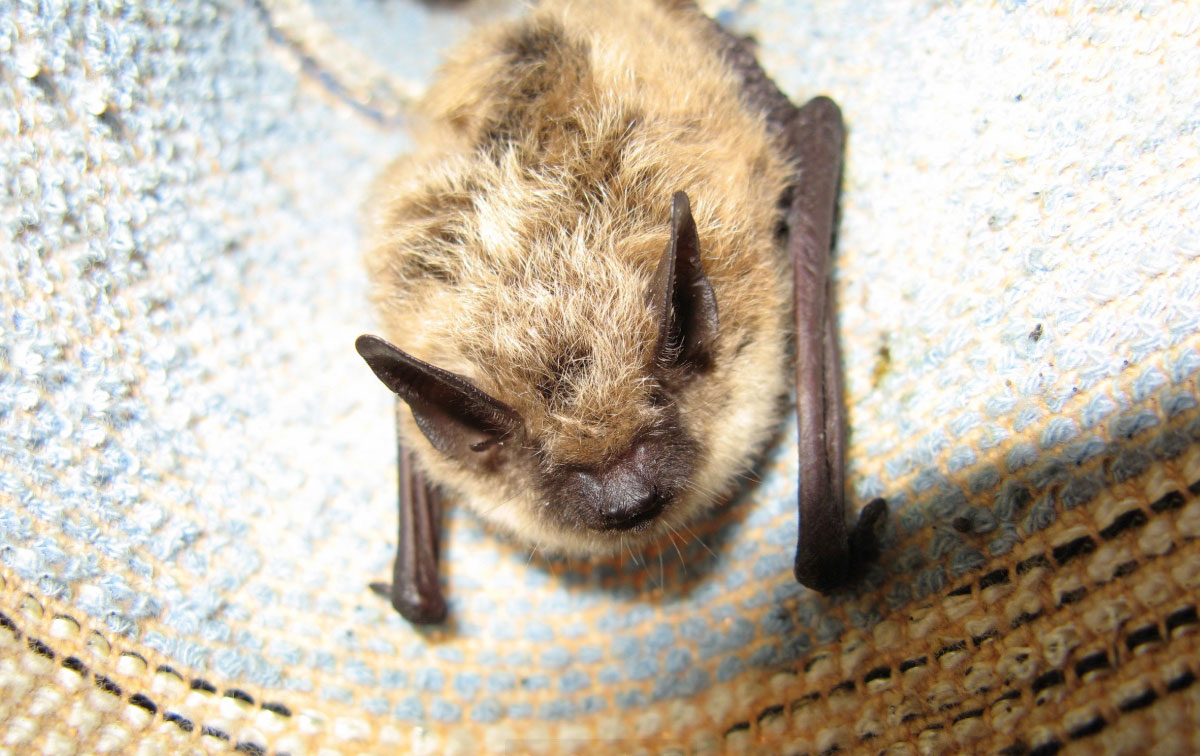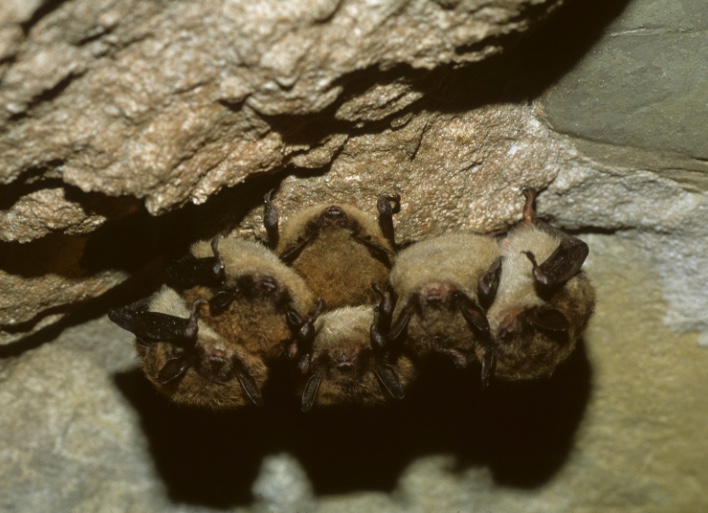
Photo: Geoffrey Ower
Learn more about bats in Illinois in OutdoorIllinois Journal:
Bats help keep insect pests such as mosquitoes and moths under control.
Illinois is home to thirteen species of bats. They are all small, winged mammals, most weighing less than one ounce. The head and body are covered with fur, and the wings are constructed of hairless membranes (patagia) that connect the hind legs, body, and long forelimbs. The wing membranes extend over the four fingers, but the clawed thumb remains free. Another membrane connects the small hind legs to the tail.
All of Illinois’ bats are insectivorous. Since they hunt insects, they have a plentiful food resource during spring and summer. However, as cooler weather sets in, bats must either migrate to warmer areas where they can continue to find food or find a place where they can hibernate over the winter to conserve their energy. Four of the 13 bat species may use buildings at some time of the year in Illinois. For the full list of species found in Illinois, see the Habitat & Food section on this page.
Bats are insectivorous and eat a wide variety and huge quantities of insects. It has been estimated that a single bat may consume 3,000 insects in one night. Bats begin foraging for insects at dusk. After a couple of hours, they return to a roost to rest or nurse their pups. Foraging continues occasionally throughout the night, with the final feeding occurring around dawn.
These species are known to hibernate in Illinois.
Little brown bat (Myotis lucifugus): Colonial. Both sexes roost together in caves and mines during the winter. During the spring and summer, females form nursery colonies in hollow trees, under loose bark on trees, or in buildings. During the summer, males live alone or in small colonies, roosting in trees, in rock crevices, or under siding or shingles of buildings. During the fall, both sexes roost in trees.
Northern long-eared bat (Myotis septentrionalis): Colonial. In winter both sexes roost in mines and caves. In the summer females form small nursery colonies in hollow trees, under loose bark, or in little-used buildings. Males also will roost in caves during spring and summer. This species is listed as federally endangered effective January 30, 2023.
Indiana bat (Myotis sodalis): Colonial. Both sexes roost in caves and mines during winter. During the summer, females form small nursery colonies and roost underneath exfoliating bark of trees. Males form small colonies during the summer and may roost in caves. This species is federally endangered and state endangered.
Southeastern myotis (Myotis austroriparius): Colonial. Both sexes roost mostly in caves, but also in mines, tunnels, hollow trees, buildings, culverts, and under bridges where caves are not available. This species is endangered in Illinois.
Tri-colored bat formerly known as Eastern pipistrelle (Perimyotis subflavus, formerly Pipistrellus subflavus): Both sexes roost singly or in small groups in caves and mines during the winter. In summer, females form moderately-sized nursery colonies (up to 50 individuals) in caves, cliffs, or under the eaves of buildings. Males are solitary during the summer.
Big brown bat (Eptesicus fuscus): During the winter both sexes roost in caves, tunnels, rock crevices, hollow trees, or buildings. Females form nursery colonies in hollow trees or attics during the spring and summer. Males are typically solitary during the early part of summer and roost in crevices in buildings or caves. Both sexes may be found together in roosts in late summer and fall.
During the winter, some individuals of these species hibernate in Illinois, while the rest migrate to adjacent states or farther south.
Gray bat (Myotis grisescens): Colonial. Roost in caves year-round. This species is federally endangered and state endangered.
Eastern red bat (Lasiurus borealis): Solitary. Roost in trees in both winter and summer. In winter, they use crevices or hollow trees. In summer, they can be found hanging from the outer limbs of trees. In spring and fall, they sometimes use shrubs or tall weeds as a roosting spot.
Silver-haired bat (Lasionycteris noctivagans): Small colonies. Roost under bark and in tree cavities in wooded areas. They may occasionally occupy buildings or caves during the winter, though most migrate south.
Rafinesque’s big-eared bat (Corynorhinus rafinesquii): Colonial. Roost in caves, mines, and buildings. Unlikely to overwinter in Illinois. This species is endangered in Illinois.
Eastern small-footed bat (Myotis leibii): Only known to occur in two counties in southern Illinois. It prefers upland habitat with exposed rocks and caves. It will roost under rocks on the ground. This species is listed as threatened in Illinois.
These species are typically not found in Illinois during the winter.
Hoary Bat (Lasiurus cinereus): Solitary. Roost in trees, usually in the foliage, but occasionally in cavities.
Evening Bat (Nycticeius humeralis): Colonial. Roost in trees or occasionally in buildings.
The droppings of bats and mice are fairly easy to tell apart. Mouse droppings are small, hard, cylindrical pellets that are generally scattered about. Bat guano has a shiny appearance and is brittle due to the remains of insects. The guano is usually found in piles near the roost.
Big brown bats, little brown bats, Northern long-eared myotis, Eastern red bats, and tri-colored bats are common throughout Illinois. Some of the other species of bats have limited distribution or are relatively uncommon in the state. The cave regions of southern Illinois and the valleys of the Mississippi and Illinois rivers have the highest abundance of bats and natural bat habitat.
Bats are the only mammals that are capable of true flight. Some species of bats are stronger fliers than others. All are nocturnal (active at night) and hunt for insects. During the day, bats roost (rest) hanging upside down or tuck themselves into small crevices where they are protected from weather and predators.
Bats use echolocation to orient while flying and to help them catch their prey. A bat uses its mouth and larynx to emit ultrasonic sound pulses. Once the sound makes contact with an object in the surroundings, an echo is bounced back and is received by the bat. Using the echoes, the bat can determine the size and shape of an object, how far away it is, which direction it is, and whether it is moving. The bat then uses this information to avoid obstacles in its flight path and to hunt insects. The sounds that bats emit are at such a high frequency that humans cannot hear them.
Despite common misconceptions, healthy bats do not attack humans. Bats may bite as a defense if people attempt to handle them.
Despite educational outreach efforts, many myths still exist about bats. Most species have declined because of loss of habitat, and in some cases because of human persecution. Bats are an important predator of insects and help keep insect populations under control. Guano deposits in some caves have been mined for fertilizer.
Like all mammals, bats are livebearers and nurse their young (called pups). Depending on the species, females give birth to one or two pups each year, usually in May or June. The Eastern red bat gives birth to three to five pups. Bats do not build nests. Some species form groups of females (maternity colonies). A typical summer roost could be beneath loose tree bark, in hollow trees, in abandoned buildings or attics, or in caves. At birth a young bat clings to its mother. When the mother feeds each evening, the young bat is left at the roost site. After about three weeks, the young can fly and will start feeding on insects, but they will continue to nurse until they are about 1½ months of age.
In Illinois, three to five percent of the bats tested each year have rabies. Rabies is usually fatal if not treated. Care should be taken to avoid contact with bats. The Illinois Department of Public Health provides an Rabies Surveillance Map Archive.
Bats have few parasites, and those found on bats do not normally infect humans.
If a bat accidentally enters your home, do not panic. If the bat has not bitten anyone, here are the steps to take:
If you are not sure if the bat has bitten anyone, then follow these steps recommended by the Illinois Department of Public Health:
If a bat has been near sleeping people, especially children, it should be tested for rabies. Bat bites are small, and the person may not realize that he or she has been bitten. It is better to err on the side of caution and have the bat tested. Testing is done on the dead bat’s brain, so it is important not to damage the carcass before testing. If the bat tests positive for rabies, medical attention is needed. A series of rabies shots will need to be given.
A bat found on the ground is likely a sick or injured bat or a pup that is just learning to fly. When a bat is on the ground, it is very vulnerable and may be aggressive. Do not attempt to pick up a grounded bat.
If children or pets are in the area, it is better to remove a grounded bat so that they do not come into contact with it. Wear a pair of leather gloves, place a plastic bowl or coffee can over the bat to capture it, and slide a piece of rigid cardboard underneath. Keep the cardboard held firmly to the bowl as you pick both up. If the bat bit a person or pet, keep the bat for rabies testing and call the local Department of Animal Control. If the bat did not come into contact with humans or pets, release the bat at the base of a tree away from children or other animals. Place the bowl on the ground and slowly slide the cardboard out. Quickly remove the bowl and walk away from the bat. If the bat is healthy, it will soon gain its bearings and crawl up the tree.
During the spring and early summer, bats may set up maternity colonies in buildings. During the winter, bats may hibernate in groups in buildings if natural shelter is unavailable. If at all possible, let the bat colony remain for the season. If the colony cannot be tolerated, hire a Nuisance Wildlife Control Operator with bat experience or an Illinois Department of Natural Resources district wildlife biologist can provide advice on how to deal with the colony or issue a nuisance animal removal permit.
Bats, like most wild animals, try to avoid human contact. However, due to loss of their natural habitat, bats may establish roosts in attics or abandoned buildings. The best way to avoid contact with bats is to exclude them from buildings on your property.
If you wish to attract bats to your property to help control insect populations, but do not want them living in buildings on your property, consider providing bat houses. Bat houses can be purchased or you can build your own. Bat house plans are available from several organizations, including Bat Conservation International.
Permanent eviction of bats may be performed during these periods:
1) March 15 through May 15 when outdoor temperatures exceed 50° F at dusk;
2) August 5 through October 30 when outdoor temperatures exceed 50° F at dusk and the permittee has made a reasonable attempt to determine that young are capable of flight. (IL Admin Code, Section 525.55 Bats)
It is better to prevent bats from entering buildings in the first place by sealing any holes or gaps. However, if bats have already taken up residence, watch the exterior of the building from dusk (half an hour before sunset) until it gets dark outside to determine the entrance(s) to the roost site. Bats typically enter buildings through openings in the roof, eaves, dormers, or gables or via the chimney, attic or roof vents, or holes or gaps in siding. Seal all gaps of ¼ x 1½ inches or holes 5/8 inches diameter or greater. Seal minor points of entry first. After bats leave the roost in the evening, temporarily seal all major entrances with a one-way door made of wire or plastic mesh.
One-way doors can be made of ¼-inch wire screening. Use a 2- to 3-foot piece of wire to cover the hole (there should be 3 to 5 inches between the structure and the wire to give the bats room to crawl out). Secure the top and sides of the wire to the building using staples or duct tape. Leave the bottom section open. After all bats have left the building (this may take several nights), permanently seal all openings. One-way doors should be in place before the young are born in May and June to prevent the young from starving after the mother has been excluded from the site. If there are young bats inside the building, wait until they are weaned (late July to August) before excluding the bats and sealing all entrances. Bat Conservation International provides good information on exclusion techniques.
There are not any repellents for day roosts, but if bats roost briefly on porches or other structures at night, dog or cat repellent sprays can keep them away. Spray the area before the bats come to roost.
Bats may be evicted or excluded without a permit by the property owner as long as it is not during the maternity period and the weather conditions are suitable so that bats have a chance for survival. See Legal Status below. If a nuisance wildlife control operator is hired, they must have a permit from the IDNR. Bats should not be harmed or killed, even if a nuisance permit has been issued. For full details see the Legal Status section.
In Illinois, bats are protected under the Illinois Wildlife Code. However, the property owner can remove bats from the living quarters of their home or business at any time after consultation with the IDNR. This does not allow people to kill or harm bats, but they can be removed from your home or business per the conditions of Administrative Rule 525, Section 525.75.
The best solution for bats inside a home is generally to: 1) block any entrance into the living space of the home (finished rooms where people live), 2) wait until the young bats are mobile and able to fly and fend for themselves, and then 3) conduct a permanent eviction of bats that keeps them out of the home by sealing up all entrances into the home. This is the best way to protect people and their homes from damage.
Permanent eviction may be performed from May 16 through August 4 and/or October 31 through March 14 ONLY IF ALL OF the following conditions are met:
If these four conditions are met, a Nuisance Animal Removal Permit (NARP) and Endangered Species Permit (if needed) will be issued to the landowner and their nuisance wildlife control operator. Definite species identification is needed to determine if federal and/or state endangered species permits are needed.

Photo: Adele Hodde, IDNR

Illustrator: Lynn Smith
The Wildlife Illinois website was authorized by the Illinois Department of Natural Resources (IDNR) in partial fulfillment of project W-147-T. The website was developed by the National Great Rivers Research and Education Center, 2wav, and the IDNR in partnership with the United States Department of Agriculture Animal and Plant Health Inspection Service Wildlife Services and University of Illinois Extension to provide research-based information about how to coexist with Illinois wildlife.